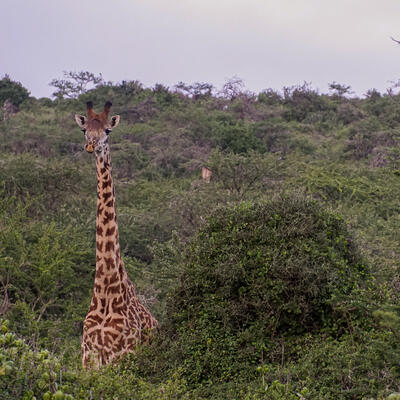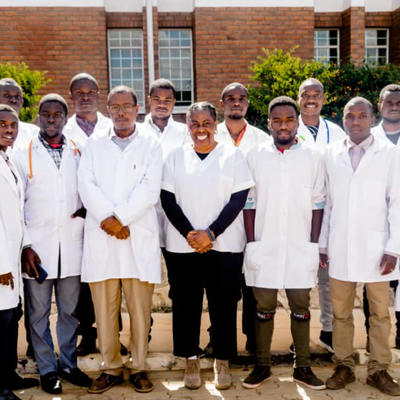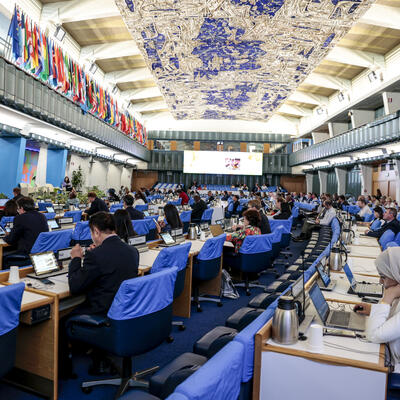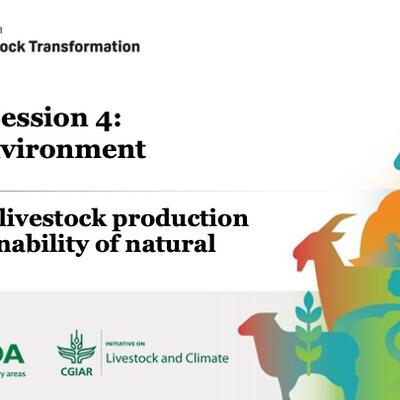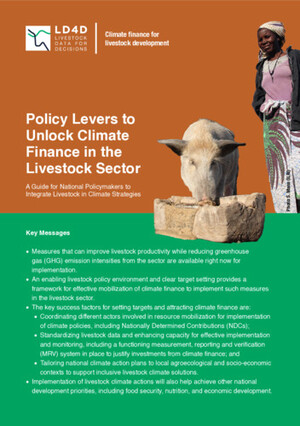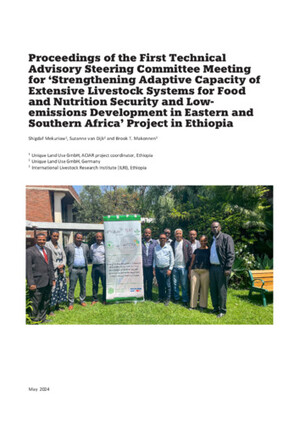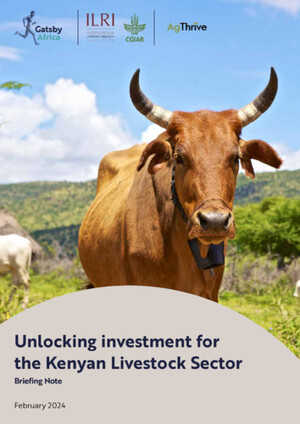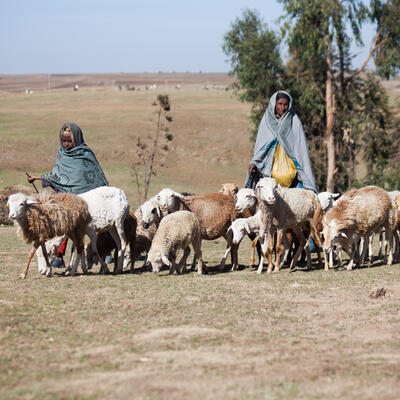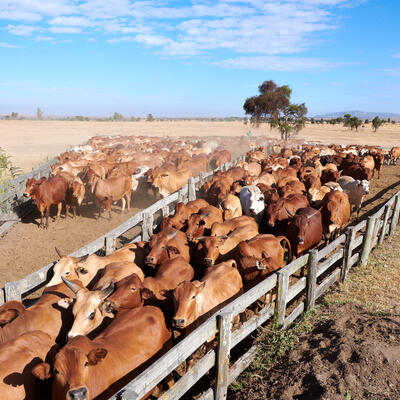
COVID-19: 'A terrible thing to waste'—One Health policy seminar
Five scientists from the International Livestock Research Institute (ILRI) participated last week in rich conversations about COVID-19 and use of One Health approaches to prevent such pandemics in future.
The ILRI researchers (and many others—please check the seminar webpage for a full list of speakers) made short presentations in a policy seminar co-hosted by ILRI’s sister CGIAR centre, the International Food Policy Research Institute (IFPRI), and the CGIAR COVID-19 Hub.
Below are excerpts from the seminar lightly edited for clarity and brevity.

Janet Hodur, senior communications specialist for the CGIAR Research Program on Agriculture for Nutrition and Health, skillfully moderated the seminar and began by introducing Ekaterina Krivonos, CGIAR deputy director of programs, who opened the seminar by saying that One Health is a vital part of the CGIAR’s response to the pandemic. ‘Because many infectious disease epidemics are “zoonotic”—they are transmitted from animals to people—we need to improve their prevention and to better detect and respond to zoonotic outbreaks that do occur. This required applying a One Health approach that investigates the close connections between people, animals and our shared environments.’
***
John McDermott, director of the CGIAR Research Program on Agriculture for Nutrition and Health, then framed One Health in the context of agri-food systems. As McDermott explained, investigating human, animal and environment health together would make for a dauntingly broad research approach except for the fact that One Health work focuses specifically on the ways in which links among the health of people, animals and environments encourage (or discourage) spillover infectious disease events.
‘The concept of One Health has been around for quite a while—since at least the early 20th century. But these were mainly academic discussions; One Health as a pragmatic approach to disease control never really took off.'
So why is One Health so important now? Why, with COVID-19, is One Health increasingly prominent?
—John McDermott
‘In my opinion, One Health has become so prominent because it is critical to human health for three big reasons. First, a lot of the epidemics, pandemics and emerging diseases that we are all worrying about—some 75% of them—originate in animals.
‘Second, in the last 5 to 6 years, we have begun to understand the importance of food safety. Ensuring food safety is a big concern in the fast ‘transitioning’ food systems of lower and middle-income countries that are changing dramatically.'
We now know that the burden of food-borne diseases due to microbial contamination of perishables is very high in these countries—comparable to that of malaria, HIV and TB.
—John McDermott
‘Third, is the increasing development of resistance in pathogens to antimicrobial drugs. This is a huge concern for the health community, which worries that increases in antimicrobial resistance will deplete the antibiotics we use to treat common infections. Although we don’t yet know the One Health dimensions of antimicrobial resistance, we do know that huge quantities of antimicrobial drugs are given to livestock and fish.'
The number of emerging infectious diseases leading to epidemics and pandemics is increasing.
COVID-19 has expanded our ambitions for One Health because it is the perfect storm of a health crisis—it is a health crisis, a food crisis, an economic crisis and a social crisis all rolled into one.
The question for CGIAR scientists is, where health, food and economics come together, what do we do for the poor?
—John McDermott
‘Finally, a recent report I produced with scientists Bernard Bett and Delia Grace at ILRI shows that the hotspots of disease emergence over the last couple of centuries have been in Asia due to the high density of people and animals in that region, to the ways forests are used there, and to the ways Asian people and their domesticated animals interact with wildlife.
‘Until now, these densities have not been replicated in Africa. But they’re coming. So we can expect future epidemics in Africa to be bigger and more frequent due to Africa’s growing human populations, animal populations and incursions into forests. So we can expect more infectious zoonotic diseases to arise in Africa in future.’
***
This overview by McDermott was followed by several 'rapid-fire' (two-minute) presentations, including ones made by four ILRI scientists: agricultural economist Steve Staal (USA), veterinary epidemiologists Hu Suk Lee (Korea) and Annie Cook (Australia) and molecular biologist and genomicist Samuel Oyola (Kenya).
***
Steve Staal spoke on links between bushmeat value chains and zoonotic risks. What, he asked, is driving bushmeat value chains and what are the implications of those drivers for disease risk? The following results that he presented are based on an extensive literature search.
• Some 40% of households at forest margins across Africa participate in bushmeat value chains.
• The level of economic activity in bushmeat is very large—tens of millions of dollars, possibly more—and generates important livelihoods for both men and women.
• The levels of rural bushmeat consumption are very high, ranging from 20–30 to 100 grams per person per day.
• Bushmeat plays a key role in providing people with nourishing animal-sourced foods.
• Where cheap meat from livestock is available, consumption of bushmeat is reduced.
• In spite of the visibility of bushmeat markets, most hunting for bushmeat is driven not by market demand but by consumption needs in rural households.
• The level of understanding of zoonotic risks among bushmeat hunters and consumers is generally poor and few of the actors handling bushmeat employ any disease risk mitigation practices.
• Until recently, the monitoring of bushmeat value chains focused on wildlife conservation and consumption issues and basically ignored the zoonotic disease risks of bushmeat hunting, marketing and eating.
These results make apparent the need to:
> conduct research on improving community understanding of zoonotic disease risks
> explore livestock meat alternatives to bushmeat consumption
> develop community-based bushmeat management strategies
> create monitoring methods that integrate issues in wildlife conservation, bushmeat consumption and zoonotic disease risk
—Steve Staal
***
Hu Suk Lee described how ILRI is monitoring the interspecies transmission of the coronavirus along the wildlife supply chain in northern and southern Vietnam with the aim of improving disease surveillance and preparedness in the country.
***
Annie Cook described associations between slaughterhouses and COVID-19 in Kenya.
‘A year ago, news that slaughterhouse workers in the U.S. and Europe were at increased risk of COVID-19 caught my attention. The risk factors seemed to be crowded conditions; low temperatures, moisture and dust in the work environment; and the low socio-economic and migrant status of many in the workforce.
‘We looked at slaughterhouse workers in Kenya. While conditions in Kenya are different to those in the North, there are also similarities in the use of migrant workers, the typically low socio-economic status of the workforce, and high levels of moisture and dust in the work environment.
‘We are working with our Kenyan partners in Kiambu County and the Ministry of Health to collect baseline data. Our aim is to understand the seroprevalence in the county, to identify groups within and without the slaughterhouses that are at high risk of COVID-19, and to develop within ILRI’s laboratories an in-house ELISA (enzyme-linked immunosorbent assay) for the serology testing.'
We’ll be able to use the data we collect to understand links also between other zoonotic diseases and slaughterhouse workers.
—Annie Cook
***
Samuel Oyola described ways ILRI is supporting the Kenya government in COVID-19 testing.
‘At the onset of the COVID-19 pandemic in Kenya, the government asked ILRI to support its COVID-19 testing. With generous funding from BMZ, we tested more than 30,000 samples between June and December 2020.
‘When new virus variants of concern started spreading, the Kenya government requested ILRI’s support in tracking the new variants using genomic surveillance technology. This work started just last month. We have so far detected several variants, including two of special concern—B.1.1.7 and B.1.351—that are circulating in the population.'
Of the samples we have tested so far, the UK variant B.1.1.7 has become dominant. And we have discovered other emerging virus variants of interest that we are still evaluating.
—Samuel Oyola
‘This work is funded also by the CGIAR Research Program on Livestock.’
***
Jeff Waage then led a session on how to collaborate effectively in One Health across sectors. Waage is an agricultural scientist managing research programs in UK universities, including the London School of Hygiene and Tropical Medicine, where he supports the ‘Improving Human Health’ program of the CGIAR Research Program on Agriculture for Nutrition and Health A4NH, a collaboration between LSHTM, ILRI and the Royal Veterinary College focusing on agricultural interactions with disease, as distinct from nutrition.
***
In this session, Allan Tollervey, head of agricultural research at the UK’s Foreign, Commonwealth and Development Office, had much to say about what’s needed to change ‘siloed’ thinking and approaches to combatting zoonotic diseases.
‘The COVID-19 virus jumped the species barrier over a year ago and is now being transmitted human to human. While that has happened, we are asking ourselves, How do we stop the next spillover, the next big zoonotic disease, which are coming, and coming more frequently. What drives the emergence of these diseases? How do we best respond to that? How do we use a One Health approach to think through the problem? How do we use One Health to address foodborne diseases, antimicrobial resistance, zoonotic diseases?'
I’d say that in the past we’ve done pretty poorly in bringing One Health to bear on a global policy approach to these problems.
—Allan Tollervey
'The Tripartite initiative among the Food and Agriculture Organization of the United Nations, the World Organisation for Animal Health and the World Health Organization works to some extent. But it hasn’t really created the framework for a genuine joined-up One Health approach to identify and mitigate in coherent ways the risks of zoonotic spillovers.
‘I think the efforts around controlling avian influenza were not all successful, partly because it’s been difficult to get a One Health approach embedded in governments. What’s important for us is assembling an evidence base to make the case in an irrefutable way that to solve these problems, to reduce the risk of zoonotic spillovers, we need to act in new ways.
‘The "health people" think about COVID-19 as a health problem. It is a health problem. But they frame and define the issue as just that.'
First, to get health professionals, who outnumber animal health professionals around about ten to one, and have ten times the budget and ten times the political interest, to think about food systems as a driver of zoonotic diseases, you need to present some pretty strong and compelling evidence.
Their current way of thinking about zoonotic diseases is incomplete.
—Allan Tollervey
‘Second, you need to get professionals working in governments and international agencies who are able to think in broader ways. The way both health professionals and animal vets are trained is very siloed and within a very top-down, hierarchical education system. This tends to produce people who think about the health system as a health system (only). They struggle to think more broadly.
‘Third, you need to present your evidence and argument in ways that make such a compelling case that ministers and policymakers feel unable to respond in their traditional ways.
‘Assembling an evidence base is really important but you need to also build in incentives for people to start acting in new ways. Right now most governments, including the government system I work in, is still highly siloed in the ways it tends to think about problems. We need broader understanding outside academic institutions, which by and large are good at trying to think in much broader ways. Until that happens, we’re not going to get that sort of operational One Health approach embedded into the system.
‘We’ve had a series of zoonotic spillovers in the last twenty years. Each time there’s been a short-term response, and actually quite a lot of investment, but that response and investment have not been sustained, they have not been targeted particularly well, and they have not led to the sort of system transformation that is needed to reduce the risks of zoonotic spillovers and emerging pandemics.
‘Although evidence alone isn’t enough, knowing what works—having some certainty that what we’re trying to do is based on things that we’ve done in the past that have worked, and we’re clear about what the evidence tells us in terms of both what works and what doesn’t work—is really, really important.'
Assembling evidence in ways that we can actually act on it is also important.
—Allan Tollervey
'Individual studies here and there are really useful, but we need a more comprehensive evidence base, particularly to address three things. First is to understand what the drivers of zoonotic disease emergence are (we have only a very partial understanding of that as yet) and what the risk factors are. Second is to understand how to mitigate those drivers while not causing farmers undue hardships (e.g. making recommendations that farmers can’t follow). And third is having a suite of tools and technological solutions—better vaccines, better biologicals—that we can deploy to respond quickly and effectively when disease outbreaks do occur.'
All of these things are needed. But we need to understand—much better than we do now—how to do these things where these risks are actually emerging.
—Allan TollerveyWe’re in a unique position now, in terms of resources for, and interest in, zoonotic diseases and One Health approaches to stem them. If we can’t make the best of this, it’s our own fault.
—Jeff WaageClearly.
—Allan Tollervey

Graphic above by Annabel Slater, ILRI digital media and content specialist and social media manager.
***
Next up was Hung Nguyen, co-leader of ILRI’s animal and Human Health program. Nguyen co-founded the Center for Public Health and Ecosystem Research at Hanoi University of Public Health, where he developed a regional research portfolio on agri- and environmental health.
As bad as COVID-19 is, it has created opportunity to make people aware of the importance of the One Health approach.
—Hung Nguyen
'The CGIAR Research Program on Agriculture for Nutrition and Health has been working on One Health for the last eight years and will continue to build on that foundation.
‘Historically, the One Health approach has been very much promoted and championed by those in veterinary medicine. With both human and animal health fairly well covered, what remains most neglected are the environment and socio-economic aspects.
‘We need more evidence of how One Health is operationalized on the ground, particularly in the global South.’
***
If this pandemic isn’t an impetus to get moving on zoonoses, I don’t know what is. A few things are happening. But not fast enough and not systematic enough.
—John McDermottOne Health has really only been applied successfully where there is a specific problem that it has been used to address, whether that be TB in India or Nipah in Bangladesh. To build such multidisciplinary muscle, you need to apply the One Health approach to something that can be defined, so that you can see what the solution would look like.
—Allan Tollervey
***
Allan Tollervey then responded to a question from the audience by raising the issue of trade-offs.
‘There is an element of trade-offs implicit in One Health, as there is in climate change work. You have to accept that there are costs, for example, to prioritizing animal welfare. Many programs try to ensure high standards of animal welfare. We would expect those costs to be reflected in the operational costs of the animal production system. That might reflect greater sustainability but with short-term economic losses.
‘Issues around health sustainability imply some degree of trade-offs in objectives. We would expect those to be rationally managed. For example, if in the long run we have to de-intensify agricultural production systems to reduce use of antibiotics and their spillover into the environment, we would see that as a win-win—better for the animals and better for us in the long run. While incurring an economic cost, we would see that as definitely worthwhile. But we need to attach metrics and analyses to such work—not just make generic and non-specific arguments. Arguments should be grounded in high-quality research and have a strong evidence base so that we can manage trade-offs in a responsible way.’
***
John McDermott brought the seminar to a close by suggesting ways to help governments do One Health better.
‘We’ve heard about silos and cross-sectoral challenges. In a way, our systems of government make it necessary for different sectors to compete. Health competes with agriculture, for example, for resources and budgets. Some of the new alignment will have to be forced from the top.'
If we can’t figure out a sustained response to such a crisis, we’re not going to learn much. This has been a big drama, and it’s going to go on for a good while.
—John McDermott
‘What did policymakers learn from SARS [severe acute respiratory syndrome]? The countries in East Asia learned a lot from SARS. And it really helped them respond to COVID-19.Korea, Vietnam, Taiwan—they all learned a lot.
‘I come from a country, Canada, that also thought it had learned a lot from SARS. Canada was badly affected by SARS. Canada rearranged its whole public health system to fight SARS. But then Canada didn’t sustain its effort. Canadians had a wonderful surveillance system that they were sharing with the rest of the world. They dropped it. They didn’t follow the advice and the evidence necessary to do the right things. They just didn’t sustain their effort—even though they had invested a lot in battling SARS.'
I hope there are closed rooms where policymakers can go and discuss their failures (without having to share them with the rest of us). That would be helpful for learning. That will be important going forward.
—John McDermott
‘There are many strengths in the different sectors we are dealing with that we can exploit. The health sector, for example, is really good at requiring very specific pieces of evidence and following the evidence.'
I’ve never had a minister of agriculture ask me what evidence I have that a given program is going to work. But ministers of health ask you that all the time! ‘Is this going to work?’ ‘Where’s the field trial?’ ‘What’s the social burden?’ ‘What’s the economic cost?
—John McDermott
'While health workers rely on evidence, sometimes that evidence is too narrow. That’s where food systems and agricultural workers can come in, because they can offer a broader perspective.'
One of my lessons from COVID-19 is that we have really failed the poor. Totally.
—John McDermott
‘We haven’t been systematic about helping poor people obtain basic services, which cut across all these issues—health, food, education, water—these are basic needs. Thinking about what their poorest people need and how they could meet that need would be a great thing for governments to do.
‘Another challenge is how to achieve sustained day-to-day efforts, where all people know whose job it is to do what thing.
‘Tackling avian flu wasn’t a total disaster. It did get health people talking to vets and others—people who had never talked to each other before in Africa and Asia. We can build on that. The labs, the testing, the cold storage, the skills, the research—these should and can all come together.'
Finally, a lot of people talked today about communities. We had a question as to whether anyone takes an environmental or animal health perspective over a human health perspective.
And the answer is—communities do.
—John McDermott
'I had the privilege as a young vet of working in a pastoral community in what is now South Sudan. These people value animal health far more than human health. They drove their system on animal health because those animals sustained their survival.
‘There is a similar situation with environment health. Communities of forest-dwelling peoples and those who work with them know that the forest is what sustains them. They have a deep understanding of how and why they have to look after the health of their forest environment.'
We can learn much from these local communities about One Health approaches that really work.
—John McDermott
Articles to read
Responding to COVID-19: CGIAR's contribution to global response, recovery and resilience, CGIAR System Organization, 2020.
Preventing the next pandemic: Zoonotic diseases and how to break the chain of transmission. United Nations Environment Programme and International Livestock Research Institute. 2020. Nairobi, Kenya: UNEP.
ILRI Blog article: A One-Health approach is needed to protect both people and the planet—ILRI and UNEP leaders, 2020.
On the topic raised by John McDermot about sustainable community uses of their local environments, readers may want to read this new article, The miracle of the commons: Far from being profoundly destructive, we humans have deep capacities for sharing resources with generosity and foresight, published by Michelle Nijhuis in Aeon, 4 May 2021.
Websites to visit
CGIAR COVID-19 Hub, which ILRI strongly supports through the CGIAR Research Program on Agriculture for Health and Nutrition.
CGIAR One Health Research, Education and Outreach Centre in Africa (OHRECA), hosted by ILRI and funded by BMZ.
ILRI landing page on ILRI expertise on zoonotic diseases.
Videos to watch
Watch the whole 1.5-hour 4 May 2021 policy seminar, which includes many more speakers:
CGIAR COVID-19 Hub Seminar: COVID-19 and Implications for One Health Research.
Watch this ILRI 2021 video short explainer (2 min.):
One Health: Why Livestock Matter
Watch this ILRI video short (2.5 min.):
ILRI Expertise on Zoonotic Diseases







